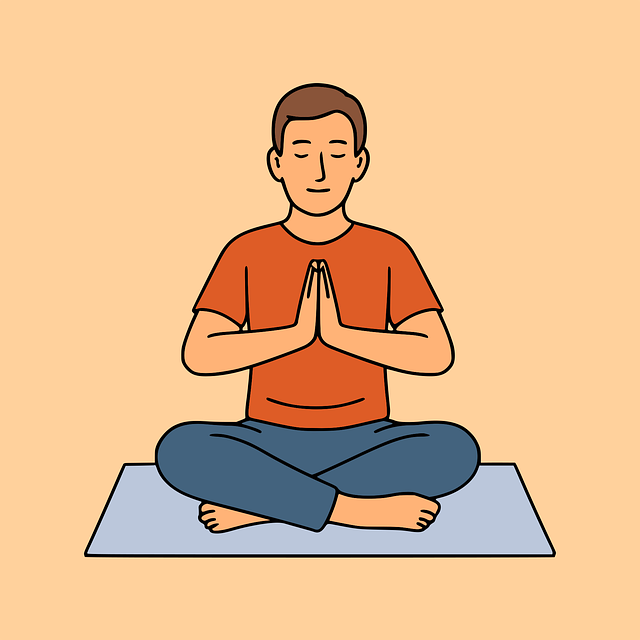Stress management through yoga for anxiety is a powerful approach. By identifying personal triggers and incorporating holistic practices like physical postures, breath control, and mindfulness into your routine, you can reduce stress hormones and gain resilience against daily pressures. Even short daily sessions of yoga have been proven to improve mental clarity, lower cortisol levels, and enable individuals to handle stressors more effectively. Additionally, building healthy habits like regular exercise, quality sleep, and balanced diets further enhance stress coping abilities, fostering a calmer and more composed response to life's challenges.
In today’s fast-paced world, managing daily stressors is essential for maintaining mental well-being. This article offers practical tips and strategies to navigate life’s challenges effectively. We explore the impact of understanding and recognizing triggers, with a focus on yoga as a powerful tool for anxiety management. Learn poses and techniques to find calm and balance. Additionally, discover mindfulness and relaxation practices to build resilience and cultivate healthy habits for long-term stress navigation.
- Understanding Daily Stressors: Recognizing Triggers and Their Impact
- Yoga as a Tool for Anxiety Management: Poses and Techniques
- Incorporating Mindfulness and Relaxation Practices into Your Routine
- Building Resilience: Healthy Habits for Long-Term Stress Navigation
Understanding Daily Stressors: Recognizing Triggers and Their Impact

Stress is an inevitable part of daily life, but understanding your triggers can empower you to manage it effectively. Daily stressors can stem from various sources, such as work pressures, financial worries, or even minor inconveniences. Recognizing these triggers is the first step towards managing stress. For many, certain situations or environments can act as catalysts for anxiety and tension. For instance, a packed commute may cause road rage, while a cluttered workspace might contribute to feelings of overwhelm.
Yoga for anxiety has emerged as a popular practice to counteract such stressors. Taking a few minutes each day to focus on your breath and move your body through gentle stretches can help calm the mind and reduce stress hormones. By identifying your personal triggers and incorporating practices like yoga, you can develop tools to navigate daily stressors with greater resilience.
Yoga as a Tool for Anxiety Management: Poses and Techniques

Yoga is a powerful tool for managing daily stressors, particularly anxiety. It combines physical postures, breath control, and mindfulness, offering a holistic approach to calming the mind and body. For those dealing with yoga for anxiety, several poses and techniques have proven effective in reducing stress levels and promoting relaxation.
One pose, known as the Child’s Pose (Balasana), is a simple yet profoundly soothing stretch that helps quiet the nervous system. Another, the Cat-Cow Pose (Marjaryasana-Bitilasana), facilitates deep breathing, enhancing relaxation and flexibility. The Downward-Facing Dog (Adho Mukha Svanasana) invert the body, increasing blood flow and releasing tension from the spine and shoulders—common areas of anxiety-related tightness. Techniques like mindful breathing, where you focus on slow, deep inhales and exhales, can significantly lower stress hormones and create a sense of calm.
Incorporating Mindfulness and Relaxation Practices into Your Routine

Incorporating mindfulness and relaxation practices, such as yoga for anxiety, into your daily routine can significantly reduce stress levels. Yoga, in particular, combines physical postures, breathing exercises, and meditation, which have been scientifically proven to lower cortisol, the stress hormone, and promote mental clarity. Even a short 10-minute session each day can make a noticeable difference in how you handle stressors throughout the rest of your day.
These practices help you become more aware of your thoughts and feelings without judgment, allowing you to detach from stressful situations. By cultivating a present-moment awareness, you gain a new perspective on challenges, making it easier to manage them effectively. Whether it’s through guided meditation, deep breathing techniques, or gentle yoga poses, these activities create an inner calm that can be drawn upon during moments of heightened stress.
Building Resilience: Healthy Habits for Long-Term Stress Navigation

Building resilience is a key aspect of navigating daily stressors effectively. Incorporating healthy habits into your routine can significantly enhance your ability to manage stress in the long term. Regular exercise, such as yoga for anxiety, has been scientifically proven to reduce stress hormones and improve mental clarity. Even a short daily practice can make a noticeable difference, promoting relaxation and better coping mechanisms.
Additionally, prioritizing quality sleep, maintaining a balanced diet, and engaging in mindfulness practices contribute to a robust stress-coping toolkit. These habits create a stable foundation for managing stressors, allowing you to respond rather than react to challenging situations. By adopting these strategies, you empower yourself to navigate life’s twists and turns with greater resilience and composure.
Navigating daily stressors effectively involves a multi-faceted approach. By understanding your unique triggers, incorporating mindfulness and relaxation practices into your routine, and adopting healthy habits that build resilience, you can manage stress in the short and long term. Yoga, specifically tailored for anxiety management, offers powerful poses and techniques to calm the mind and body. Remember, managing stress is a personal journey; these practical tips provide a starting point for fostering mental well-being and enhancing your overall quality of life.
